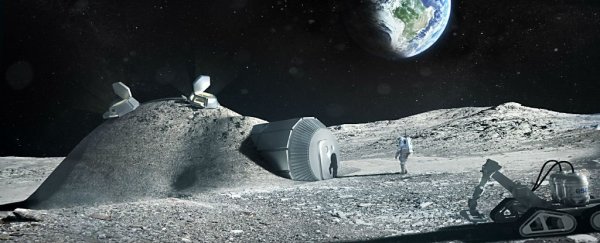Welcome to Lunar Park. You'll find the ice melting and filtering plant to your left. Low-G tennis is up there on the crater rim. Oh, and here's the passkey to your new robo-fab domicile.
Visions of lunar life are a perennial of science fiction fashion, but the European Space Agency (ESA) takes its "Moon Village" scheme very seriously as the next leap forward in space exploration. As time passes, however, there remains the question on just who will get the ball rolling.
Presenting at the 2017 European Planetary Science Congress in Riga, Latvia, ESA Moon Village ambassador Bernard Foing set the scene for community life on the surface of our planet's largest natural satellite.
And we're not talking stuffy white-walled laboratories and machines that go ping.
Starting from a colony of six to ten pioneering astronauts laying down the foundations, Foing suggested the numbers could boom.
If we get cracking, we could have a decent little colony of a hundred or so underway by 2040.
"In 2050, you could have a thousand," Foing told AFP, explaining how families would naturally be joining long-term lunar researchers and developers.
Naturally you couldn't have families without expecting the odd space baby to be conceived.
According to Foing, "there may be the possibility to have children born on the Moon."
Forget the hotel-like International Space Station (ISS) – to sustain a thriving community for long periods, the Moon Village would require using local materials to sustain life and build structures.
That would mean finding ways to grow plants and develop large scale 3D printing technology based on the Moon's regolith and ore, and extract water from icy deposits.
It would also mean providing space for leisure and entertainment, inspiring thoughts of creative new low-G sports and hobbies.
Are you sold yet?
With the ISS due to be decommissioned by 2024, space-based low-G research will need to look elsewhere for somewhere to conduct research.
The ESA's Director General Jan Woerner has described the Moon Village scheme as a key part of Space 4.0, following the dawn of astronomy, space travel, and sustained periods of living in space on space stations.
Following in the tradition of the ISS's international collaborations, the Moon Village won't be flying any single flag over its printed huts.
"The Moon Village is open to any and all interested parties and nations," Woerner explained last year.
Humans haven't set foot back on the Moon since astronaut Gene Cernan stepped into the Apollo 17 Lunar Module on 13 December 1972.
Forty years is a long time, and aside from speculation and a few blueprints, there's no sign of a base – what are we waiting for?
"We still don't have the top leaders interested," says Vidvuds Beldavs of the University of Latvia, who runs a project called the International Lunar Decade.
While those authorities were once political leaders with competing interests on the international stage, a new era is emerging where companies competing within a global market are taking on the role of space exploration.
Competitions like Google's X-Prize and citizen funded endeavours like Elon Musk's Space X are examples of new ways we'll be making the leap from Earth to the stars.
Romantic thoughts of living on the Moon within 20 years aside, none of this is considered a walk in the space-garden.
Physicist Christiane Heinicke should know – she spent a year cooped up in a mock off-world habitat among the barren lava fields of Hawaii.
"Being either inside the habitat or inside a suit means that you're never able to actually feel the moon/planet you're on," Heinicke told AFP.
While the Moon Village might have the luxury of being able to stretch out over the surface, Heinicke also warns there's no escape from crew mates, testing domestic bliss in what would be one, long camping trip.
Whether the rewards would be worth the effort, time would tell.
Helium 3 could be mined and returned to Earth, which would make great fusion reactor fuel. Of course, that would require a market for fusion reactor fuel.
Lunar water could be split and turned into rocket fuel as well, turning the Moon into a far cheaper launch base for long distance missions to the far reaches of the Solar System… and beyond.
Whether this is enough to keep up the inspiration of citizen scientists with deep pockets, or attract the attention of governments to pour funding into research bodies, is anybody's guess.
Foing remains optimistic. In the short term, good old space tourism might help foot the bill, with 100 million euro tickets to Moon Village helping cover some costs.
"That's now, but in 20 years, the price of the ticket could be 100 times less," says Foing.
Anybody for a few holes of lunar golf?
